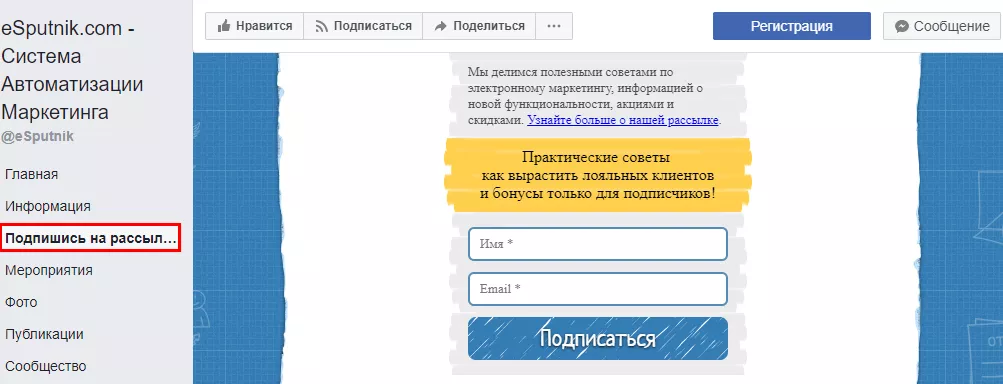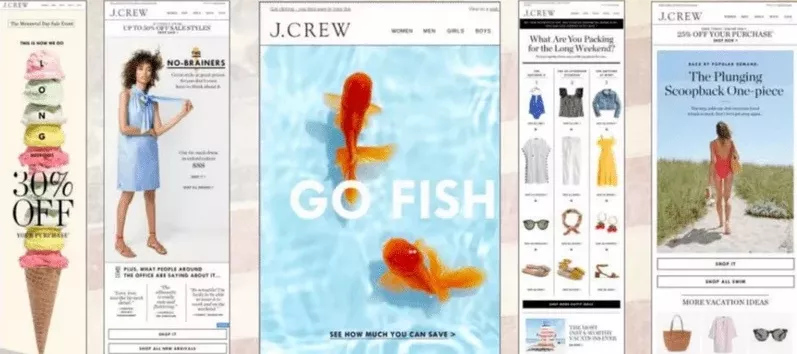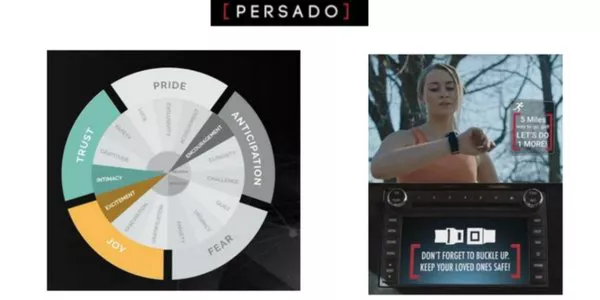How to Gain the Trust of Email Subscribers in the USA: The Yespo Experience
If you’ve built a database and launched an email campaign in the USA, you may find nothing new in this article. But if you haven’t, then read on and discover email marketing practices in the USA for yourself.
Most importantly, put what you learn into practice, and be sure to share your successes in the comments. You may just achieve results as amazing as those of Natalia Ustimenko and Alexey Danchenko (Yespo), who spoke about email marketing in the US at last year’s 8P conference.
Let’s start by looking at how to increase the number of subscribers on your email marketing list. I believe you’ll find a lot of familiar methods here.
Top 10 ways to collect email addresses for your newsletter
- Forms on the main page, product card, or website footer
- Popup windows.
- Exclusive sections for subscribers only.
- Collecting email addresses after an order.
- Social networks.
- Offline questionnaires.
- Business cards.
- Contests.
- Push notifications and SMS messages.
- Affiliate newsletters.
All of these methods can and do work, but the folks at Yespo figured out how to build a base more efficiently. When they entered the US market, they learned about the methods Americans use to grow their subscriber base, increase subscriber loyalty, and convert them from readers to customers.
Each niche requires its own email marketing strategy, from building a database to regular mailings. By using different methods and tricks implemented in simple and clear ways, you can also bring customers to your website and grow your email list.
Change your subscription form regularly
How often do you change your subscription form? Let’s be honest. Probably never, or once every five years, if you change your logo or website design. In the USA, it is uncommon to stick to one form for an extended period of time. Instead, businesses like to try different ones to suit their mood or the season, and they always try to surprise potential subscribers.

Your regular subscription form is like a favorite pair of jeans. You know it suits you, so you wear it all year round. Of course, it is comfortable, but a change will go a long way toward surprising those around you.
There are special services for changing subscription form layouts in the USA, such as Privy. The important thing is that people aren’t afraid to use widgets created by others. Sometimes, business owners may not want to put someone else’s script on their site in our industry. OK, write your own, but change the subscription form regularly.
Use interactive capture forms
Another effective and popular method is interactive capture. These are elements that require the user to do something. For example, a wheel of fortune. The site visitor is offered a chance to spin the wheel, and they do so. The person receives a 10% discount when the wheel stops, but they have to enter their email address to use this discount.
Promote on social networks
You can successfully grow your subscriber base without a website. If you have high-quality and professional product photos, well-written descriptions, and a regularly updated and well-managed social media profile, then you can build your subscriber base.
How? Publish a subscription form on your social media page.
Facebook is a great way to collect lots of new subscribers. Why? On Facebook, they can see that the product is being used and the service is in demand, and this encourages them to trust your products and your company.
Encourage users to invite friends
Would you trust a company recommended by a good friend? For some of you, it may be the only way to choose who to contact, where to place an order, or where to buy a product. In the US, this is a very common method used to attract a huge subscriber base.
When a person receives a discount or bonus from filling out a form, they will be asked to add three more email addresses and share their bonus with their friends. If the user doesn’t want to add email addresses, there are several alternate ways to share the discount with friends, such as sharing a link to Facebook, Instagram, or Twitter. The user can then choose the network they use most.
Work hard and build a real database
Unfortunately, buying a database is still common and considered an acceptable way of collecting email addresses. It’s up to you but be prepared for a minimum return on campaigns based on purchased databases. We recommend compiling your own database instead. For instance, collect business cards and meet people at trade events.
Don’t hesitate to communicate and learn about their business, challenges, and needs. This will help you choose the right approach for each person. You’ll also have the advantage of being introduced in your first welcome email.
Then, send an email. Start with the person, not with yourself. What should you say?
Hello [Name],
My name is [...].
It was great meeting you at [...].
I’ve been thinking about the [challenges] you mentioned [in sales, communication with clients, promotion] – don’t rely on memory, and start with the event’s theme or the section of the conference. Move on to what you can do to help them.
Include an actual photo of the event in your email (background, header, or body). Perhaps there was a memorable figure at the event (an administrator in branded clothing or a person in a pigeon costume). Even if the recipient doesn’t remember you, they will surely recall the context. And the reader will be more likely to trust you.
Such an email should be concise, and self-referential language should be kept to a minimum. Needless to say, this will guarantee you the favor of a new subscriber.
How do I ensure my emails reach the subscriber’s inbox?
This is one of the biggest pain points and the main question for everyone involved in email marketing. How do you avoid getting marked as spam? First, refrain from spamming (sending seven emails weekly is a very bad practice). You also have to consider all the technical requirements of email services.
Here is a step-by-step plan to prevent emails from going to spam.
1. Set up SPF, DKIM, and DMARK.
2. Set up Double Opt-in:
- launch a welcome email series;
- use throttling for large email campaigns.
3. Change the email structure:
- study the links;
- check email design elements;
- set up corporate email addresses.
4. Send emails regularly, perhaps once a week.
5. Automate:
- reactivation emails;
- lifecycle emails.
Configure SPF (Sender Policy Framework), DKIM (DomainKeys Identified Mail), and DMARK (Domain-based Message Authentication, Reporting and Conformance).
An SPF record gives email services information about which servers can send emails from your domain and what to do with those that cannot.
DKIM is a digital signature confirming that the message was sent and authorized by the owner of a domain. If you don’t have this signature, the service will consider your reputation to be unreliable.
DMARK is a filter confirming that the email comes from a trusted and reliable service. To get this filter, add the domain record to your DNS settings.
Another requirement for newsletters is to set up Double Opt-in. This is when a person is asked, after subscribing, to confirm if they really want to receive your emails.
You should also make sure that the structure of your email is correct.
- It is recommended to have a minimum number of links in an email and to check the design elements of the email. Specifically, don’t overfill your email with images because this is a direct path to being flagged as spam.
- Set up corporate email addresses, as email services automatically identify emails from free domains as spam.
- Set up regular weekly emails and automate reactivation and lifecycle emails.
Follow the corporate style
It’s bad practice to send emails without a consistent structure. Impersonal emails are even worse: it needs to be clear who they’re from. And it’s not just the signature. The cover, the background, the order of the blocks, the logo, the CTA buttons, and the position of the social media links — all of these elements should be personalized and placed correctly.
Take a look at how corporate identity is maintained in the US:
Customize your content
In the US, services that help create subject lines are highly popular. A well-crafted subject line can increase email open rates by up to 100%. Take the Persado service, for example. It creates content based on the topics people respond to best. If you open emails with depressing subject lines more often, you’ll get an email with a similar subject line. If you like something cheerful, you’ll likely get an email with a positive subject line.
Read more about email marketing in our blog:
- The Creative Side of Retention Marketing: How to Create Inspired Emails that Captivate Your Subscribers
- How I Achieved a 39% Response Rate After Sending Cold Emails to 100 of the Most Influential Experts in B2B Sales
- How a New IP Address Can Break Into the World of Big Email Campaigns: Warming Up a Newbie
Conclusions
How do you build a vibrant and warm subscriber base in the US and turn them into customers and true brand advocates?
- Use various subscription forms and pages on your website, such as interactive capture forms and forms on every page.
- You should encourage users to invite friends from social media networks in your emails.
- Use the power of social media to attract newsletter readers. Create content you want to share and add an option to subscribe via social media.
- Collect email addresses legally.
- Connect with your subscribers on a human level — don’t sell or push your services from the first email.
Related Articles
How to Set Up Consent Mode in GA4 on Your Website with Google Tag Manager
Let's explore how to properly integrate consent mode in GA4, configure it for effective data collection, and at the same time comply with GDPR and other legal regulations
Display Advertising Effectiveness Analysis: A Comprehensive Approach to Measuring Its Impact
In this article, I will explain why you shouldn’t underestimate display advertising and how to analyze its impact using Google Analytics 4
Generative Engine Optimization: What Businesses Get From Ranking in SearchGPT
Companies that master SearchGPT SEO and generative engine optimization will capture high-intent traffic from users seeking direct, authoritative answers






